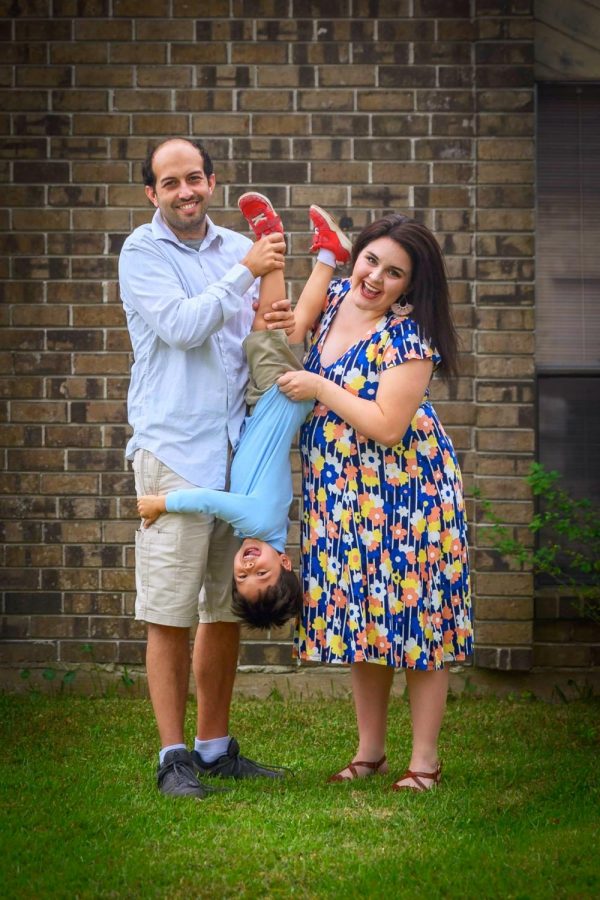Pregnant women cope with giving birth during COVID-19
Ali Solino and her family pose ten days before she delivered her baby. Solino said that while her experience was seamless, it felt spooky delivering in a hospital with no visitors. Courtesy of Ali Solino.
April 29, 2020
In April 2019, Loyola A’11 Melanie Shannon became pregnant after a year and a half of trying. Ten weeks later, she was devastated with the news that she lost her baby.
“That last summer was just this really hazy grief-filled period; I was just kind of ready to throw in a towel and say we are not going to do this,” Shannon said.
But through her husband’s support and fertility treatments, Shannon became pregnant again in October 2019. Her excitement has now been overshadowed by the anxiety of COVID-19.
“I’m due in two months,” Shannon said. “And now here we are, the finish line is in sight, and the rug kind of got pulled out from under us with this.”
For Shannon, being pregnant during a pandemic has been a constant battle with her “inner-victim.”
“There are days where it just sucks and I hate it,” Shannon said. “But we are healthy and, more importantly, the baby is healthy and so there’s at least that.”
Now, instead of doctor’s appointments, where they would measure the baby’s heartbeat and fundal height, Shannon consults her care provider over Skype, which she said is an added anxiety.
“It feels a little less involved than I would prefer at this stage,” she said. “It makes me a little more anxious to not be able to go in and just have the basic benchmark measurements.”
Ali Solino, neonatal ICU nurse and Loyola A’10, also had to cope with virtual appointments as she reached the end of her pregnancy.
“It just kind of sucks, Solino said. “I want to go to an actual appointment where they check me and then they say, ‘OK, you’re set,’ because then they make you feel like there’s an end in sight.”
For both Solino and Shannon, the fear of the unknown regarding hospital protocol and the nature of the virus has been daunting.
“Everything is rapidly evolving and they are coming up with different protocols to protect their patients and I just don’t know what that’s going to look like in two weeks,” Solino said.
Solino said that she was already “mourning the loss” of her son Elliot not being able to meet his new baby brother in the hospital, but was later shocked to learn that her own obstetrician would not be allowed in during the birth because of the hospital’s COVID-19 policies.
“My own OB didn’t even deliver me,” Solino said. “So the doctor I’ve built a patient-provider relationship with for almost 10 years was replaced with whoever the on-call was.”
Earlier this month, some New York City hospitals banned all support, including spouses or partners, from being present during the delivery to limit the risk of infection.
The fear of “a possible surge of COVID-19 cases” has also led some pregnant women to undergo home births or have labor induced early.
Pregnant women should be considered a high-risk group because those who contract the virus are at an increased risk for birth complications such as premature births and birth defects, according to The American College of Obstetricians and Gynecologists and the Society for Maternal-Fetal Medicine.
When Solino entered her New Orleans hospital, she said she was immediately greeted with a temperature screening and a swab test for COVID-19. Her negative results meant she was able to give birth without a mask which she said made the experience more comfortable.
“So much of working through the pain of labor is breathing and focusing on inhaling, exhaling to get you through to the next contraction,” Solino said. “Since masks retain a good bit of humidity and condensation, wearing one would interrupt that focus.”
Solino described her experience as seamless, immaculately clean, but eerie “to deliver in a very quiet hospital with no visitors.”
“I did feel safe — the limited visitor policy made a big difference,” Solino said. “The healthcare workers in L&D (labor and delivery) wore masks and surgical bonnets the whole time. We were largely left alone except for occasional checks.”
While Solino already gave birth, Shannon is still awaiting her baby’s delivery, and her plans to give birth at the largest medical center in the world in Houston, Texas have been a source of both apprehension and comfort.
“Part of being in Houston is that we do have this huge medical center, so it’s kind of scary on the one hand, but on the other hand it’s a really great place to be sick,” Shannon said.
Even with frequent changes in hospital policies and livelihoods, Shannon said she is optimistic that she will be surrounded by loved ones to witness her daughter’s birth, but has accepted the possibility of going to the hospital alone.
“At the end of the day, there is a healthy baby and if that means my husband can not come to the hospital with me, if that means that my parents don’t meet their granddaughter for six months after she’s born, that’s not the picture I had painted in my head, but that’s okay,” Shannon said.
Whether in a pandemic or not, Solino lives by the motto “expect the unexpected” during pregnancy.
“Women will come to learn in their pregnancy that nothing will ever happen in a way that you thought it would,” Solino said
The Associated Press contributed to this report.








